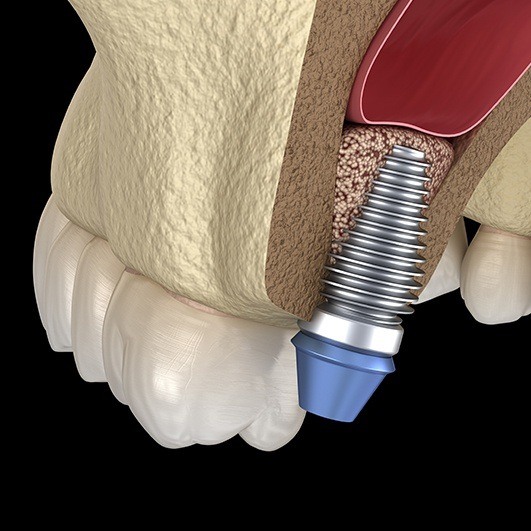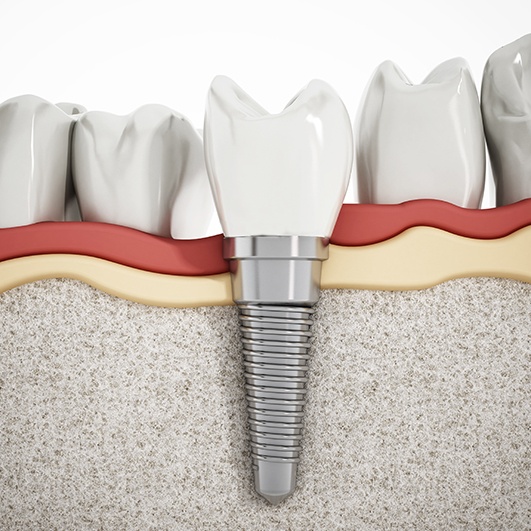Bone Grafting – Houston, TX
Preparation for Successful Dental Implant Placement
If you have lost one or more teeth, opting for a dental implant ensures you receive a sturdy, natural-looking, and comprehensive tooth replacement. If your teeth have been missing for a while, if you have had gum disease, or if you just have a small or weak jawbone to begin with, you may not have enough healthy bone structure for the successful anchoring of each dental implant. In these cases, your doctor will recommend bone grafting in Housotn, TX to prevent implant failure.
What Is a Bone Graft?

Successful bone grafts strengthen the jawbone to better support dental implants. After the dental implant is placed, the jaw gradually grows around it in the process known as osseointegration. Without plenty of supportive structure, it is difficult for the bone to fuse with the dental implant.
During the bone graft procedure, your oral surgeon takes healthy bone tissue from a donor site and places it into the treatment site. Donor tissue may be taken from elsewhere in the body or from a cow (a common donor method known as a “xenograft”). An artificial material may also be used.
During the graft, the donor tissue is placed into the area where volume has been lost. Then, over a period of several months, the graft is allowed to heal and integrate with your jaw before the dental implant is placed. In some cases, though, the dental implant can be placed at the same time as the bone graft procedure is performed.
What Type of Bone Graft Do You Need?

Your oral surgeon will decide how much new bone tissue you need and whether or not your dental implants can be placed on the same day. If it’s the upper back molars that are being replaced, you may need a special type of bone augmentation called a sinus lift since bone in the back of the jaw may be too weak or small to support dental implants. To perform a sinus lift, your oral surgeon opens the area behind the upper back molars, lifts the sinus up to create space in the area, then fills it with donor tissue.
Aftercare

If your dental implants cannot be placed on the same day, we will carefully discuss your aftercare instructions to help you enjoy a speedy, comfortable recovery. Some tips to remember include…
- Take any medications (pain killers, antibiotics) exactly as prescribed.
- Brush and floss areas of the mouth not affected by surgery as normal.
- Do not eat or drink anything until the anesthesia wears off.
- Follow a soft foods diet for the first few days after surgery.
- Avoid disturbing the treatment area with your tongue as it heals.
- Get in touch with your oral surgeon if symptoms worsen or do not improve after several days.
Questions? Contact Us Today

If you have questions about bone grafting procedures or dental implants, please do not hesitate to get in touch with the Houston experts in implant dentistry. We want to help you enjoy all the benefits of a complete, fully functional smile. Contact us to discuss dental implants today!
Bone Grafting FAQs
How Can I Tell if I Need a Dental Bone Graft?
You may need a dental bone graft if:
- A significant amount of time has passed since you lost your natural teeth. The jawbone naturally tends to deteriorate after tooth extractions. Eventually, this process can reach the point where the bone is no longer large enough to support an implant.
- Your bone is naturally thin or weak. Due to medical conditions or other issues, your bone may naturally lack the density and size needed to support dental implants.
- You suffered physical trauma. An injury can affect the bone in a way that renders it unable to support implants without a bone graft.
Our team will evaluate your oral health through X-rays, exams, and CBCT images to determine if a bone graft is necessary before you can move forward with dental implants.
Where Does the Grafted Bone Come From?
The grafted bone can come from several sources. Autografts use bone from your own body, often from the hip or another part of your jaw. Allografts use bone from a donor, while xenografts use bone from animals, usually cows. There are also synthetic options, which are made from biocompatible materials. Your dentist will help you choose the best source based on your specific condition and needs.
What Are the Types of Bone Grafts?
There are several types of bone grafts used in dental procedures:
- A socket graft, also known as socket preservation, is placed in the tooth socket immediately after extraction to prevent bone loss.
- A lateral ridge preservation graft, also known as ridge augmentation, increases the width of the jawbone.
- A block bone graft is usually used for severe bone loss. During this procedure, a block of bone is secured in the weak area of the jawbone.
- A sinus lift adds bone to the upper jaw in the area of the molars and premolars.
How Long Does It Take to Recover from Bone Grafting?
The initial recovery period usually takes 1 – 2 weeks. During that time, the soft tissue at your surgical site should completely heal. Swelling and discomfort should disappear, and you should return to feeling normal.
Over the next few months (anywhere from 3 – 9 months), the new bone material will integrate with your existing bone.
You can promote successful recovery by carefully following instructions from our team. For example, you should take medications as prescribed and adhere to a thorough oral hygiene routine.
Are There Any Risks Associated with Dental Bone Grafting?
Like any surgical procedure, dental bone grafting carries a small degree of risk. For example, there is a minor chance of infection, bleeding, and complications related to anesthesia. There is also a chance that the graft may not integrate properly with your existing bone, which may lead to the need for additional procedures. Our team will discuss these potential risks with you and take steps to minimize them.

